Contents
There are several ways to water pepper in a greenhouse. But when using any of them, you need to follow the basic rules.
Rules for watering pepper
Pepper in the greenhouse reacts sensitively to the time of introduction of water and its composition. If you treat watering without due attention, you can harm the culture.
Composition and temperature of water
Pepper prefers clean water without impurities of chlorine and other hard elements. It is best to use settled well liquid for irrigation. It has a fairly mild composition and at the same time contains valuable minerals.
The water temperature should be approximately 25°C. It is impossible to water pepper in a greenhouse with cold liquid, this can cause the culture to get sick. The soil in the greenhouse is always quite warm, so the roots of the bushes react sensitively to sudden temperature changes.
Watering time
Watering peppers in a greenhouse is necessary in the morning before noon or in the evening, after sunset. After that, it is recommended to leave the greenhouse open for airing for an hour so that excess moisture does not form. At the height of the day, the procedure is not carried out – in well-warmed soil, the roots can get burned when moisture enters. If drops of water fall on the leaves, the culture may also suffer, become covered with dry brownish spots and begin to turn yellow.
If plants in the ground require watering only in dry weather, then peppers in the greenhouse should be moistened regularly, including during the rainy season. Water in damp weather evaporates from the soil more slowly, but the earth still dries up. Ideally, both in the rain and in the heat, the soil in the greenhouse on the pepper beds should remain moderately moist.
The frequency of watering peppers in the greenhouse
Peppers don’t usually need constant watering. In moderately hot weather, plantings are moistened 1-2 times a week. If the summer turned out to be dry, and the soil dries quickly even in a greenhouse, watering is carried out every 2-3 days.
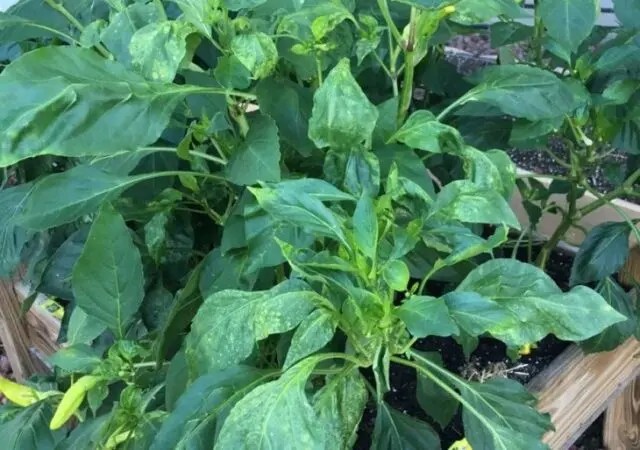
With excessive moisture, pepper often suffers from rot, mold and other ailments.
How to properly water peppers in a greenhouse
When watering pepper in a greenhouse, it is necessary to take into account the vegetation stage of the plant. At the stage of active development, the crop requires more moisture, shortly before harvesting, the need for water decreases.
How to water pepper in a greenhouse after planting seedlings
Immediately after transplanting into a greenhouse, pepper is watered up to twice a week in moderately warm weather. In warm soil, the culture takes root without any problems, so it usually does not require a large amount of moisture. If it is very hot outside, the frequency can be increased and the plantings can be watered once every two days.
At 1 m2 soil in this case, it is necessary to spend 10 liters of water. It is better to irrigate peppers less often, but more abundantly than to constantly add a small amount of moisture to the soil. In the latter case, the likelihood of developing fungi increases.
How to water pepper in a greenhouse during flowering
During the flowering period, the pepper expends a lot of energy and needs more liquid than usual. It is necessary to apply moisture under the root of the plant at least twice a week. In the heat, it is allowed to water even daily, if the condition of the soil in the greenhouse requires it.
It is important to ensure that water does not fall directly on the buds. Irrigation of above-ground parts harms the crop, flowering may slow down or stop.
How to water pepper in a greenhouse during fruiting
At the first stage of fruit formation, pepper must be moistened every 2-3 days so that the ovaries are large and plentiful. At the same time, 3-5 liters of water are consumed per plant, depending on the size of the bush.
Watering pepper in the greenhouse during the ripening period shortly before harvesting should be done in minimal quantities. It is enough to moisten the plantings every four days, observing the previous volumes of fluid application.
Watering methods
Peppers can be watered in several ways. The mechanical method of introducing moisture is usually more convenient, but requires the construction of special devices.
Manual
Manual watering is the most affordable and easiest of all methods. Peppers are moistened with a watering can or water is poured under the root of the plants directly from the bucket. The procedure is carried out in the morning or in the evening, until the planting is illuminated by the bright sun, they try to direct the liquid so that it does not fall on the leaves of the culture.
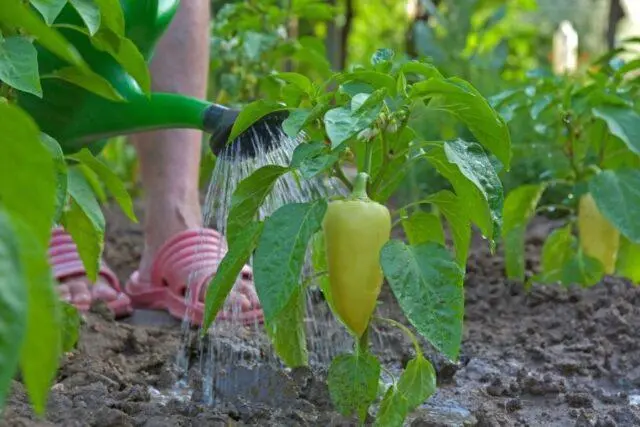
It is convenient to manually apply liquid top dressing for peppers at the same time as watering.
Automatic
The automatic method of watering involves the installation of a special system in the greenhouse, equipped with smart sensors. Moistening of plantings in this case occurs without the direct participation of the gardener. At the right time, the system automatically turns on, waters and goes into an inactive state until the next time.
The disadvantage of automation is its high cost. Installing the system requires a large investment. The site must have permanent sources of water supply and electricity. It is necessary to correctly think over and implement the installation of the system in the greenhouse.
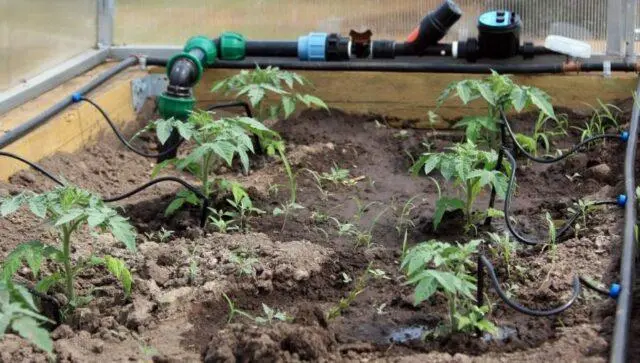
In the presence of an automatic watering system, the pepper in the greenhouse receives water on time, even in the absence of a gardener
Mechanical
A mechanical irrigation system is similar to an automatic one, but requires constant human supervision. Usually, several irrigation or sprinkler installations are located in the greenhouse, connected to hoses, and the latter are connected to sources of water and electricity. To irrigate, it is necessary to manually open the taps on the pipelines and ensure the supply of fluid. The system is then turned off again.
Mechanical watering is convenient because it facilitates the work of the gardener and allows you not to waste extra time on manual moistening. But during the absence of people in the country, the peppers in the greenhouse will not be able to receive water, since there will be no one to put the system into action.

With mechanical irrigation, a lot of water is consumed, so you need to turn on the system for no more than half an hour
Sprinkler
Sprinkler irrigation is most often used for outdoor peppers. Sprinklers in this case throw water up, and it falls on the beds in frequent drops, simulating natural precipitation.
In a greenhouse, the method is rarely used, because against the background of its use, the humidity of the air rises sharply. The greenhouse has to be ventilated more often, and as a result, the mechanical irrigation system does not simplify, but only complicates the care of the vegetable crop. Another disadvantage of sprinkling is that it cannot be used during the flowering period – water should not fall on the pepper buds.

Sprinkling for peppers can be carried out only in cloudy weather without bright sun
Drip irrigation of peppers in a greenhouse
Drip irrigation is the most popular. Its essence lies in the fact that pipes or hoses with small holes near the pepper bushes are laid between the beds in the greenhouse. Water in this case enters directly under the roots of plants in small quantities, but constantly.
The method is convenient in that when using it, the soil in the greenhouse remains moderately moist, but does not turn sour. When watering, the liquid does not fall on the green parts of the plants. The system does not require special control, it is only important to replenish the main source of water supply in time.
When installing drip irrigation, it is recommended to provide taps that allow blocking the flow of moisture. It is easiest to install shut-off valves in the place where the system connects to a large water tank. But from a practical point of view, it is more convenient to mount separate taps for each bed, in which case watering can be dosed for different parts of the greenhouse. If the soil in the greenhouse dries unevenly, pepper bushes will not suffer from waterlogging or lack of fluid.
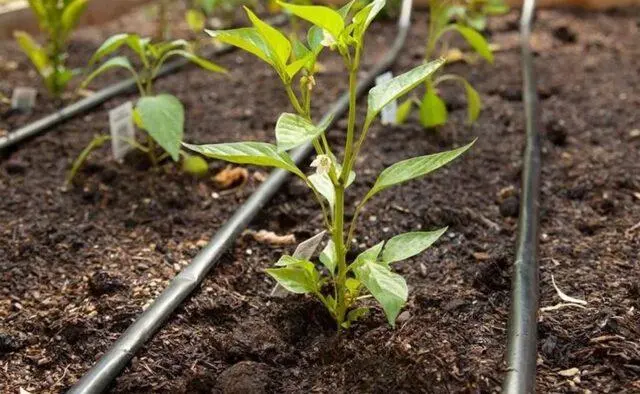
To create a drip system, usually flexible hoses are used, in which it is easy to make small holes.
The nuances of watering
To provide peppers with high-quality watering, you need to consider in which greenhouse they grow. The type of greenhouse determines the level of humidity and the need of plants for liquid.
In a polycarbonate greenhouse
Polycarbonate greenhouses are characterized by good light transmission and thermal insulation. It is recommended to use drip or mechanical methods for watering peppers. Such a moisture system allows you to provide planting with a sufficient amount of liquid, while not flooding the growing bushes.
The average water consumption for irrigation in a polycarbonate greenhouse is 10 liters per 20 small plants. According to the usual rules, the culture is moistened more actively during flowering and the formation of ovaries. Watering peppers in a polycarbonate greenhouse during fruiting is minimized so as not to impair the quality of the crop.
When using this type of greenhouse, it is especially important to pay attention to regular ventilation. They are carried out in a one-sided way so as not to create a draft in the greenhouse that is dangerous for peppers. Even at the stage of planting the crop, you need to make sure that there are enough windows in the greenhouse.
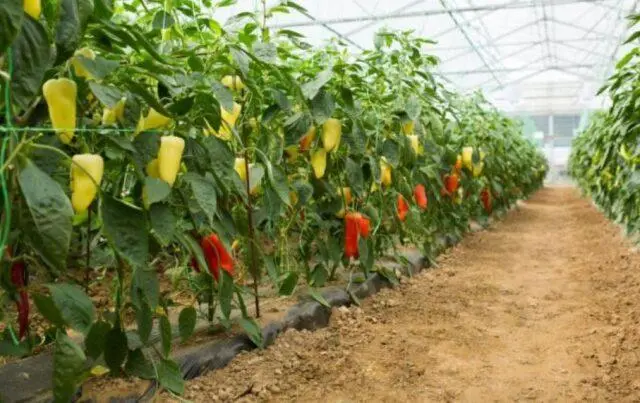
Two weeks before harvesting, watering of peppers in a polycarbonate greenhouse is completely stopped.
In a greenhouse under a film
In film greenhouses, peppers grow in conditions of high humidity and often suffer from a lack of fresh air. Therefore, special care must be taken when watering.
Most often, for small greenhouses, a manual humidification method or a drip system is used. The latter should be equipped with shut-off regulators to stop the flow of water to the plants if necessary. As in all cases, the amount of moisture must be correlated with the actual state of the soil. If the soil is swampy, then even in hot weather, the next watering should be canceled and attention should be paid to ventilation.
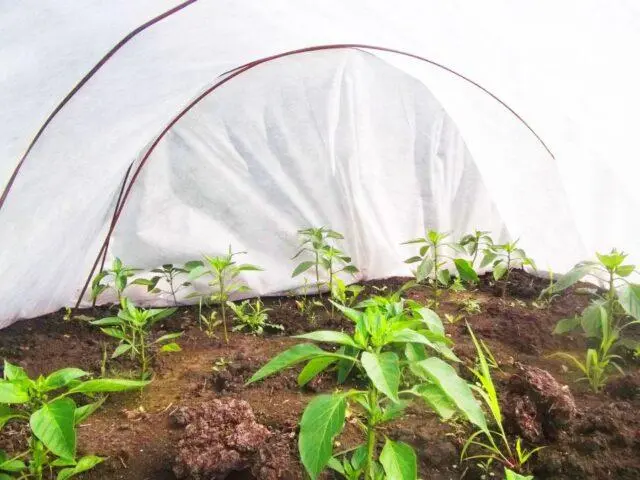
In a film greenhouse, pepper should be properly moistened even when planting, pouring 2 liters of water into each well
When to stop watering
Peppers need moisture throughout the growing season, with the exception of the fruiting period. About two weeks before harvest, watering should be completely stopped. Ripening vegetables in this case will be juicier and will not crack. In addition, limiting the amount of moisture can stimulate the formation of new flowers at the end of fruiting. It is possible that in this case it will be possible to harvest the crop again.
It is necessary to stop watering at any stage of the growing season of peppers with signs of waterlogging of the crop:
- when slowing down the growth of bushes;
- with yellowing and wilting of leaves;
- with decay of stems and roots;
- when pests or slugs appear on the bushes;
- with the formation of soft spots or mold on ripening vegetables.
Against the background of excess moisture, peppers often suffer from fungal diseases. The latter can affect both seedlings and adult bushes that are at the stage of ovary formation or fruiting.
When grown in a film greenhouse, peppers must be constantly ventilated. In this case, it is impossible to create a draft, the greenhouse is opened for a short time and only from one end. It is also recommended to regularly loosen the soil to a shallow depth so that oxygen enters the roots of plants.
Tips and Tricks
When moisturizing greenhouse peppers, you must follow some rules and useful recommendations:
- Simultaneously with watering, it is useful to apply liquid organic and mineral top dressings. In particular, in spring, manure with a high nitrogen content can be diluted in water at the rate of 1 kg per bucket. When watering pepper in a greenhouse in September, 10 g of superphosphate and 20 g of urea are added per 10 liters. Such a solution improves the fruiting of the crop and increases the juiciness of vegetables.
- When grown in a greenhouse, peppers are recommended to be tied to supports. Fruits in conditions of high temperature and humidity ripen especially juicy and massive, so the stems of bushes can break under their weight.
- It is impossible to water pepper in a greenhouse in the heat using hard tap water. It is better to use melted, rain, well liquid, and only after settling in a barrel in the sun for at least 12 hours.
- If the composition of the water still remains too hard, you can add wood ash to it at the rate of 250 g per 10 liters. The powder will soften the liquid and enrich it with useful minerals.
In heavy clay soil for greenhouse pepper plantings, watering is carried out less frequently. On sandy soil, the bushes need more frequent moistening, since the water evaporates much faster.
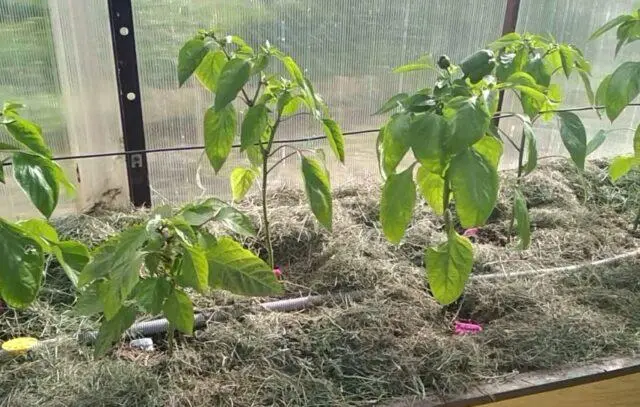
In order for the water to remain in the ground longer after irrigation, the pepper in the greenhouse can be mulched with straw
Conclusion
It is necessary to water the pepper in the greenhouse regularly, but so that the soil does not become swampy. Particular attention should be paid to ventilation, which reduces the overall level of humidity. In this case, the bushes will grow healthy, bring a bountiful harvest and will not suffer from fungi.









